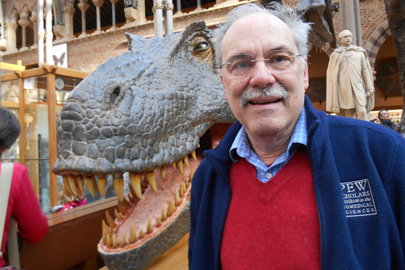The epistemology of scientific crackpottery
Chris Miller talks con artists, charlatans and heretics with BNOW
Professor Chris Miller is on loan to the University of Oxford in England, where he is the Newton-Abraham Visiting Professor in Medical, Biological and Chemical Sciences. On Monday, he gave a public lecture at the famed Oxford University Museum of Natural History — in the very room where T.H. Huxley and Bishop Samuel Wilberforce went head to head on evolution in 1860.
Miller’s main research focus is ion channels but Monday’s lectured focused on a topic close to his heart: scientific crackpots.
“I have been brooding about this topic it in a fragmentary, inchoate way for 40 years,” Miller says, “since I was a PhD student in the lab of someone I came to realize was a classic scientific crackpot.”
Miller spoke with BNOW about his lecture: "Mountebanks, con-men, and heretics: An epistemology of scientific crackpottery."
 |
|
Chris Miller at Oxford University's Museum of Natural History |
Break down this title: "Mountebanks, con-men, and heretics: An epistemology of scientific crackpottery." It sounds like you're not just talking about people who do bad science but people who purposefully use science to deceive.
You’re right. This is not really about bad versus good science. Rather it’s an examination of what I see as four different outlier scientific phenotypes: the mountebank, the con man, and two types of heretics. The first are the heretic-heroes who end up moving their fields forward, like Oswald Avery who discovered that genetic material comes from DNA or Barbara McClintock who discovered genetic transposition. The other type of heretics are the crackpots, who get stuck on a contrarian idea, become religiously attached to it, and can’t let it go in the face of steadily increasing evidence to the contrary.
Can you give me an example of particularly egregious scientific con artist?
There have been many egregious incidents of pure fraud. In 1974, William Summerlin, a rising star immunologist at Sloan-Kettering, generated great excitement by overcoming tissue rejection in skin transplants between black and white mice. Animal care technicians discovered that he colored the white mice with black markers when the “transplant” washed off with alcohol-wipes. When confronted, he admitted only to “mental exhaustion.” The fraud was discovered within two years and he ended up practicing dermatology in rural Louisiana.
Another is John Darsee in 1983. Harvard cardiologist Eugene Braunwald called him “the most remarkable of the 130 … fellows who have worked in my lab,” an assertion that turned out to be all too true. In his first 15 months at Harvard, he published five high-profile papers on cardiac ischemia. Within two years, he was confronted with outright fabrication of data for experiments he never performed and his 82 papers and abstracts were retracted. In the aftermath, he published an apology but claimed “no recollection” of having committed fraud. He became a physician in Indiana.
Who are some famous scientific mountebanks?
There are many such charlatans. My favorite is Deepak Chopra. He is a medic who fancies himself a quantum physicist, and who attracts huge gullible, fee-paying audiences — the modern version of traveling to the Lourdes grotto – to be made well through his idiotic program of “quantum healing.”
What can we learn from these mountebanks and how can we avoid their tricks?
The mountebanks are not a problem – it’s easy to detect them. Like Supreme Court Justice Potter Stewart said about pornography, “I can’t define it but I know it when I see it.” The ones who are impossible to avoid are the con men. You MUST trust people working in your own lab but it’s also necessary for PIs to stay on top of what their co-workers are doing and to have several people independently repeat important results – not because of distrust but because we can all make subtle mistakes. Nature is a lot more clever than we are.
Categories: Science and Technology





